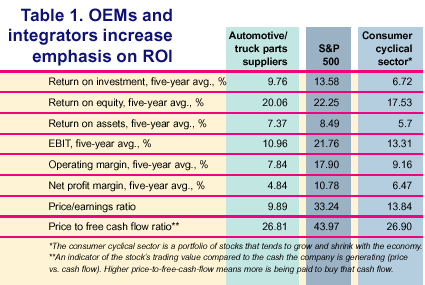A tough ride for automotive suppliers
December 1, 2001
Nobody ever said being a supplier to the automotive industry was easy, but Craig Fitzgerald, a consultant with Plante & Moran LLP (Southfield, MI) puts it bluntly: "Performance of automotive suppliers stinks."
And to back up his statement, Fitzgerald points to the S&P 500. "Auto suppliers underperform the S&P 500 in nearly every metric measured," he says. Table 1 shows a comparison of auto and truck parts suppliers, the S&P 500, and the consumer cyclical sector of manufacturing over a five-year period.
For example, the S&P 500 five-year average for return on investment was 13.58 percent, while the auto and truck parts sector saw a 9.76 percent ROI, just slightly higher than the consumer cyclical sector. Auto and truck parts makers have a five-year average operating margin of just 7.84 percent, compared to the S&P 500's 17.90 percent. Net profit margins averaged just 4.84 percent for a five-year period for auto and truck parts makers, while the S&P 500 averaged 10.78 percent.
|
Source: Market Guide from Multex.com |
Roles for each tier level in the automotive industry are rapidly changing, says Fitzgerald. OEMs will manage their brands and the customer relationship, but "they are getting out of the parts-making business," he predicts.
Tier One suppliers such as Lear, Collins & Aikman, Magna, and Venture Industries will have responsibility for entire systems and in many cases will provide customer-centered solutions and global support. Tier Ones will manufacture only highly differentiated, high-value components and assemblies. Being a Tier One will mean taking charge of consumer research and innovation, supply chain management, and system design and development.
"The average parts supplier will be bigger in size, and broader and deeper in capacity," says Fitzgerald.
Tier Two suppliers, including custom molders, will provide strategic component engineering, integrated components and modules, and collaborative engineering.
Tier Three suppliers will find themselves on the lowest rung of the ladder, providing commodity specialization and molds, tooling, and equipment to higher-tier suppliers. Tier Three suppliers will be full-service niche-product suppliers, where price is the primary selling point.
Automotive suppliers underperform the S&P 500 in nearly every metric measured. |
Hurting the Industry
There are a few things hurting the industry and Fitz-gerald doesn't hold back when talking about the situation. "Overcapacity is the single biggest challenge among automotive suppliers," he explains. "There is far too much capacity throughout the supply chain, [which is] averaging less than 70 percent capacity utilization. This drives down pricing."
Second, unethical business practices by many customers are having brutal effects on suppliers of the auto industry. "The billion-dollar bully, your customer, is using unethical buying practices," Fitzgerald told a group of moldmakers attending the Fall Conference of the American Mold Builders Assn., referencing the habit of some customers to demand price reductions, discounts, and other breaks.
Fitzgerald says suppliers' poor earning performance is not a problem of volume. "The problem is the bully customer demanding price push-downs from their suppliers," he says.
This shrinking earnings potential is exacerbated by the transfer of more capital funding responsibility to moldmakers. Receivables exceed 180 days for many moldbuilders. On top of that, the trend is to let the supplier (generally the Tier Two integrator or Tier Three molder) own the tool with the Tier One purchasing only parts. This presents greater risk for bad debt write-off.
Helping the Industry
Consolidation among major players and the fallout of weaker suppliers will help industry profitability increase and stabilize, resulting in fewer, but larger, suppliers. Fitzgerald said that total automotive global supplier revenue in 1988 was $496 billion among 30,000 suppliers worldwide, with an average revenue per supplier of $17 million.
Ten years later, total global supplier revenue increased to $958 billion among 8000 global automotive suppliers, with an average revenue per supplier of $120 million. Projections for 2008 forecast total global supplier revenue of $1.3 trillion among 2000 global automotive suppliers, with an average revenue per supplier of $650 million.
Also, adds Fitzgerald, currently the top 20 percent of automotive suppliers earn double the EBIT (earnings before interest and taxes) percentage of the rest of the industry. Watch your receivables, urges Fitzgerald. "There are many companies near bankruptcy because of poor cash flow."
The demand and trend among automotive suppliers right now are to drive down capacity. Doing so requires consolidation or, unfortunately, shutting down entirely.
Fitzgerald also advises suppliers to focus on those capabilities that differentiate them from their competitors and add value for the customer. "Don't try to do everything. Focus on execution once you've determined your differentiation and value capture," he emphasizes. "Take a specific market segment, focus on it, specialize, and be the best."
Contact information |
You May Also Like



